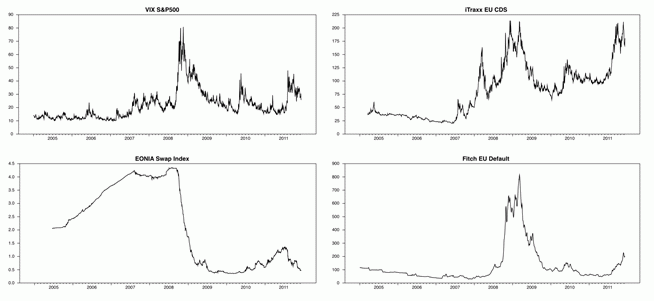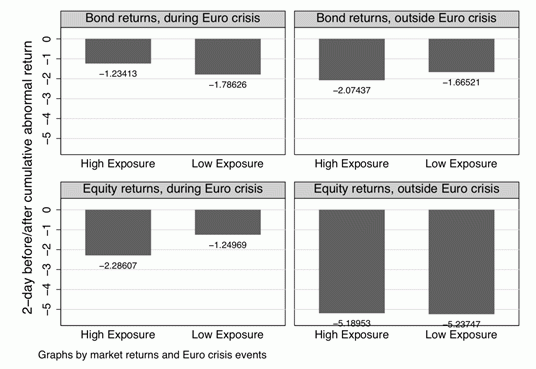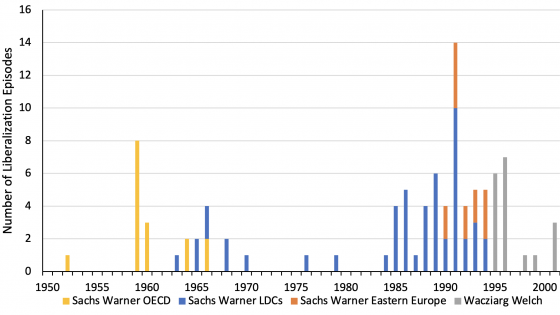Just a few years after the US-originated global crisis, the world economy finds itself confronted with another crisis emanating from the advanced economies. The Eurozone crisis currently poses the single biggest downside risk to the global outlook. The crisis is rooted in the uneven growth performance of the Eurozone countries, the unsustainably large public debts of some EU periphery countries, and Eurozone banks’ weak position, including exposure to government debt. These developments have exposed the possible dynamic inconsistency of the euro project, dubbed by Pisani-Ferry (2012) as the impossible trinity.1
The Eurozone crisis differs from the global crisis in that it has been (so far) largely confined to Europe due to the US banks’ lack of sizable exposure to the government debt of peripheral European countries. But from the viewpoint of developing countries, both crises represent major external shocks from advanced economies. The pronounced effect of the global crisis on developing countries naturally brings up the question of the potential effect of the Eurozone crisis on those countries.
In Aizenman et al. (2012) we empirically assess the scope for financial vulnerability and contagion from the EU to developing countries and emerging markets via the equity and bond markets. We apply the event study methodology to gauge the responsiveness of equity and bond markets in three regions of the emerging world to news from the Eurozone. We limit our empirical analysis to developing countries, which have relatively well-developed, deep, and liquid financial markets.2
Data and empirical specification
The sample period of our event study period encompasses both the global crisis period – i.e. the period when Eurozone news interacted with and partly reflected news from the rest of the world, in particular the US – and the post-global crisis period – i.e. the period when news from the Eurozone largely reflected Eurozone-specific news.
Our measures of the financial market linkages are derived from the fluctuations of asset returns, including the stock market and the bond market indices (MSCI Broad Investable Stock Prices (US$) and JP Morgan EMBI Bond Prices (US$), respectively). We consider the emerging market countries where the bond market and the stock market are relatively developed; these country indices are included in the MSCI and EMBI indices.
- The countries covered are Brazil, Chile, China, Colombia, Czech Republic, Egypt, Hungary, India, Indonesia, Korea, Malaysia, Mexico, Peru, Philippines, Poland, Russia, South Africa, Taiwan, Thailand, and Turkey – totalling 20 countries.
- We use the daily data of the market series of the emerging markets spanning January 2005 to December 2011.3
- We then map the emerging markets’ asset returns to the negative and positive news from the Eurozone. As can be seen from Table A1, there are numerous news items related to the Eurozone.
We proceed by investigating four quantitative indicators pointing to major macroeconomic and financial news emanating from the Eurozone, indicators that are frequently followed by the market:
- VIX S&P500, considered the “fear-gauge” of the global financial markets.
- EONIA Swap Index 3-Month, signifies a funding cost in European money markets. The rate is a weighted average of overnight euro interbank offer rate, calculated by the European Central Bank.
- iTraxx Europe 5-Year Credit Default Swap Index, considered a measure of default risk in the European capital markets. The index is tied to the most liquid 125 Credit Default Swaps of the region’s investment grade credits.
- Fitch 1-Year Probability of Default Western Europe (DataStream: FPWE01Y), provides a market view of credit condition. The index is computed from Fitch’s proprietary default database, containing approximately 27,000 entities globally, based on latest information on the size of debt, equity price, and financial statement.
The first empirical task is to arrange the window for events that appear to influence the volatility of the stock and bond returns of the emerging markets. As shown in Figure 1, the daily plots of the global financial market indicators suggest that we need to standardise the criteria to filter these financial market fluctuations.
Figure 1. Indicators of global financial volatility and the Eurozone crisis
Following a filtering procedure (see Aizenman et al 2012 for details), we extract the fluctuations of VIX, EONIA, ITRAXX, FITCH by calculating their daily percentage changes, plotted in Figure 2. From January 2005 to December 2011, we have 95 events, 23 of which are negative news since the onset of Eurozone crisis in October 2009.
Figure 2. Global news and large fluctuations
Based on the MSCI stock and JP Morgan bond indices, we use their daily returns. In our estimation, we account for the correlation across global market returns using a market model where the return of country i on day t is accounted by a country effect, and the global market return at time t. To estimate the normal returns, the above regression is done over the estimation window period from day t-70 to day t-30 (40 trading day observations). We next calculate the abnormal returns inferring the five-day cumulative abnormal returns (i.e. two days before and after the event date).
Figure 3 provides the average abnormal return on days in which an event is bad news, for different periods (during the Eurozone crisis period, outside the Eurozone crisis period) on equity market return and bond market return.
Figure 3. Average abnormal returns by event
Notes: This figure provides the average abnormal return on days in which an event is bad news since the onset of Eurozone crisis in October 2009. The exposure to the Eurozone is measured by the size of a country’s exports to the Eurozone divided by the GDP of the exporting country. The figure is calculated from the daily data: the whole sample period is 1 January 2003 to 12 December 2011; the Eurozone crisis is the period starting 8 October 2009 onwards.
We classify emerging markets according to the exposure of their economies to the Eurozone. The exposure to the Eurozone is measured by the size of a country’s exports to the Eurozone divided by the GDP of the exporting country. As expected, for emerging bond markets in the high exposure group, the negative Eurozone news has a negative effect on returns. This effect larger than the low exposure group outside the crisis but smaller during the crisis.
For emerging stock markets, the negative Eurozone news had a negative effect on returns, and this effect was larger than the low exposure group during the crisis. The evidence supports the notion that the stock markets of the high exposure emerging markets are more sensitive to the Eurozone crisis. The responses of the emerging markets during the Eurozone crisis are rather small, ranging from -1.2% to -1.8% for the bond markets and -1.2% to -2.3% for the stock markets.
Comparing these results to the events outside the Eurozone crisis, we can’t rule out the possibility that emerging market investors have already anticipated and partially priced their exposure in the overall market risks well before the troubles in the Eurozone were put in the spotlight.
Next, we estimate regressions that explain the two-day before/after cumulative abnormal return for country i for the event on date t, as accounted by a Eurozone crisis news indicator times country i exposure to the Eurozone (while controlling for global crisis period indicator and Eurozone crisis news).
Our main measure of country i exposure is the size of country i’s exports to the Eurozone divided by the GDP of country i. As alternative measures, we also use as an indicator of economic exposure: market capitalisation, saving/GDP, trade openness, and manufacturing production/value-added.
The results suggest that returns across equity and bond markets drop during the global crisis period.
According to the cumulative normal return, bad news from the Eurozone negatively affects the equity market; good news positively affects the cumulative abnormal return of the equity markets. For Emerging Asia, the average returns of the bond markets declined since the global crisis period started, whereas the average returns of the stock markets are higher. The Asian markets were largely insulated from the Eurozone news, both positive and negative events. For emerging market Latin America, both the stock and bond markets react uniformly and negatively to adverse global crisis period news.
While there is some evidence of positive abnormal returns in the stock markets, the effect of the Eurozone events on the Latin American markets during the sample period is mostly insignificant.
For emerging markets in the Eastern Europe, Middle East, and Africa, both the bond and stock markets decline since the global crisis started. As for the effect of the Eurozone events on this region, the estimation shows that the cumulative normal return of the stock market drop on the bad news (about -2.9%), while the cumulative abnormal return of the bond markets declines on good news (about -0.4%). We consistently find the negative effect of global crisis news on the stock and bond returns of the emerging markets.
Yet, except the lower return in the global crisis period, the bond markets were relatively less responsive to the news events from the Eurozone and various measures of country exposure.
Concluding remarks
Whereas the global crisis news had a consistently negative effect on returns of equity and bond markets in developing countries, the effect of Eurozone crisis news was more mixed and limited during 2005 to 2011. Yet, it is a mistake to presume the decoupling of developing countries from the Eurozone crisis. Unlike the massive financial contraction triggered by the collapse of Lehman Brothers, the Eurozone crisis has evolved at a slower pace during 2010-1, probably making it harder to identify the ultimate adverse effects of a deep Eurozone crisis on developing countries at times of heightened financial instability.
References
Aizenman, J, Y Jinjarak, M Lee, and D Park (2012), “Developing countries’ financial vulnerability to the EZ crisis: An event study of equity and bond markets”, NBER Working Paper Series No. 18028.
Arezki, R, B Candelon, and A Sy (2011), “Sovereign Rating News and Financial Markets Spillovers: Evidence from the European Debt Crisis”, CESifo Working Paper Series No. 3411.
Bekaert, G, RH Campbell, CT Lundblad, and S Siegel (2010), “The European Union, the Euro, and Equity Market Integration”, NBER Working Paper No. 16583.
Bellas, D, MG Papaioannou, and I Petrova (2010), “Determinants of Emerging Market Sovereign Bond Spreads: Fundamentals vs Financial Stress”, IMF Working Paper No. WP/10/281.
Pisani-Ferry J (2012), “http://www.bruegel.org/publications/publication-detail/publication/674-t...www.bruegel.org/publications/publication-detail/publication/674-the-euro-crisis-and-the-new-impossible-trinity/”, Bruegel report.
Taylor, JB and JC Williams (2009), “A Black Swan in the Money Market”, American Economic Journal: Macroeconomics, 1(1):58-83.
Appendix
Table A1. Economic and political events of the Eurozone.
Date
|
Event
|
04-Oct-09
|
Socialists win in Greece
|
08-Dec-09
|
Greek debt downgraded
|
14-Dec-09
|
Greece's leader calls for austerity
|
02-Feb-10
|
Greek announces austerity plan
|
03-Feb-10
|
EU endorses Greek austerity plan; Spain raises deficit forecast
|
09-Feb-10
|
Concern shifts to Portugal; Germany considers bailout plan for Greece
|
11-Feb-10
|
Conflicts over aid to Greece
|
17-Feb-10
|
Spain gets boost with new bond issue
|
23-Feb-10
|
Fitch downgrades Greek banks
|
03-Mar-10
|
Greece announces austerity plan
|
04-Mar-10
|
ECB rejects IMF involvement; Greece raises cash with new bond issue
|
05-Mar-10
|
Merkel avoids giving Greece assistance
|
08-Mar-10
|
Portugal announces budget cut and tax hike
|
11-Mar-10
|
Street protests erupt
|
18-Mar-10
|
Greek PM asks EU for loans
|
24-Mar-10
|
Fitch cuts Portugal's rating
|
25-Mar-10
|
ECB accepts BBB- as collateral; Eurozone backs Greek bailout
|
06-Apr-10
|
Greek bond yields jump to 7.1% amid deficit concerns
|
09-Apr-10
|
Fitch cuts Greece's rating
|
11-Apr-10
|
Euro finance ministers agree Greece's borrowing
|
22-Apr-10
|
Moody downgrades Greece
|
23-Apr-10
|
Greek PM says bailout needed
|
27-Apr-10
|
S&P downgrades Greece
|
28-Apr-10
|
S&P downgrades Spain
|
29-Apr-10
|
Greece agrees with IMF and EU on austerity
|
02-May-10
|
Greek bailout announced
|
05-May-10
|
Moody downgrades Portugal; euro tumbles to 14-mo low; Greek austerity plan
|
07-May-10
|
US pushes EU to act faster; Germany passes Greek bailout
|
10-May-10
|
A rescue fund for Europe agreed, 750euro
|
12-May-10
|
Spain announces public-sector wage cuts
|
13-May-10
|
Portugal approves tax hikes and spending cuts
|
19-May-10
|
Spain will raise taxes for high-income
|
21-May-10
|
Spain's central bank starts cleaning banking system
|
29-May-10
|
Fitch cuts Spain's rating
|
01-Jun-10
|
Spain faces an austerity battle
|
07-Jun-10
|
Eurozone finance ministers strike deal to create a safety net
|
14-Jun-10
|
Moody downgrades Greece
|
17-Jun-10
|
EU leaders agree to publish bank stress tests results in late July
|
13-Jul-10
|
Moody downgrades Portugal
|
19-Jul-10
|
Moody downgrades Ireland
|
23-Jul-10
|
Stress tests of banks fail to reassure
|
24-Aug-10
|
S&P downgrades Ireland
|
07-Sep-10
|
National Bank of Greece will raise capital
|
30-Sep-10
|
Moody downgrades Spain; Ireland says banking collapse will cost heavily
|
06-Oct-10
|
Fitch cuts Ireland's rating
|
18-Oct-10
|
German and France agree bondholders' sacrifices
|
26-Oct-10
|
Ireland says budget cuts are needed
|
12-Nov-10
|
Euro ministers confirm bond issued before mid-2013 unaffected by bailouts.
|
21-Nov-10
|
Ireland seeks a bailout
|
24-Nov-10
|
Ireland outlines spending cuts and tax hikes
|
28-Nov-10
|
Europe seals a 67.5euro bailout of Ireland
|
16-Dec-10
|
Permanent support fund for the Euro
|
04-Feb-11
|
Germany and France call for "pact of competitiveness"
|
02-Mar-11
|
S&P has Portugal and Greece on watchlist
|
07-Mar-11
|
Moody downgrades Greece
|
11-Mar-11
|
EU leaders agree on rules for a permanent bailout fund from 2013
|
23-Mar-11
|
Portugal's government collapses
|
24-Mar-11
|
Fitch cuts Portugal's rating
|
25-Mar-11
|
EU leaders agree on "Euro Plus Pact"
|
29-Mar-11
|
S&P downgrades Greece and Portugal
|
01-Apr-11
|
Fitch cuts Portugal's rating
|
05-Apr-11
|
Moody cut Portugal's rating
|
06-Apr-11
|
Portugal seeks bailout
|
13-Jun-11
|
S&P downgrades Greece; Germany calls for debt holders to take a partial loss
|
29-Jun-11
|
New austerity plan sparks protest
|
02-Jul-11
|
New round of aid for Greece
|
05-Jul-11
|
Portugal's debt rating cut to junk status
|
11-Jul-11
|
Worries about Italy and stand-off between PM and finance minister
|
12-Jul-11
|
Moody downgrades Ireland
|
21-Jul-11
|
New rescue plan
|
07-Aug-11
|
ECB signals intervention in bond market to protect ESP and ITA
|
06-Sep-11
|
Resistance to austerity in Italy, with a general strike
|
09-Sep-11
|
ECB Jurgen Stark resigns in protest of bond purchases
|
15-Sep-11
|
5 major banks agree to pump dollars into the banking system
|
12-Oct-11
|
Banks told to raise capital
|
26-Oct-11
|
Deal on Greek debt, banks to take a 50% loss
|
31-Oct-11
|
Call for referendum in Greece
|
03-Nov-11
|
ECB cuts rates from 1.5 to 1.25
|
04-Nov-11
|
IMF to monitor Italy's finances
|
05-Nov-11
|
Greece's leader survives confidence vote
|
06-Nov-11
|
Greek leaders reach deal to form a new government
|
10-Nov-11
|
A new leader for Greece
|
12-Nov-11
|
Berlusconi resigns
|
23-Nov-11
|
German bond auction flops
|
1 Accordingly, three attributes of the euro project that hinder the adjustment capabilities of the Eurozone countries are the strict no-monetary financing, bank-sovereign interdependence, and no co-responsibility for public debt in the Eurozone. At least one of these attributes should be modified to enhance the stability of the euro project.
2 We presume that these conditions enhance the capability to incorporate efficiently the financial markets’ expectations about the future effects of news from the Eurozone.
3 Following Taylor and Williams (2009) we define the global crisis period as 7 August 2007 onwards.









